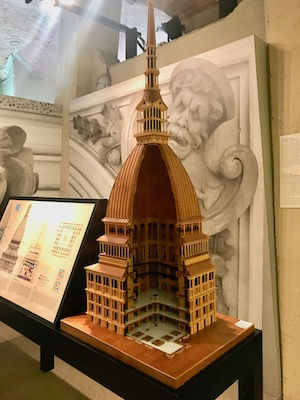La Mole Antonelliana and the National Museum of Cinema
- Amy Unfried
- May 5, 2019
- 3 min read
Updated: Nov 13, 2019
Today is our last day in Turin and our cultural expedition of the day was to the Mole Antonelliana. Mole is pronounced in two syllables, with the accent on the first, MO-lay, and it means "mass" or "bulk," or in a figurative sense "mountain" (which begs for a joke about making a mountain out of a mole hill, but I can't seem to do it)--in this case, it refers to a building of monumental proportions.

The second part of the name, Antonelli-AN-na, is because the building was designed by the architect Alessandro Antonelli, and I have learned that it is easiest to say this six-syllable word if I say the four syllables of his name in a normal way and then add "Anna" at the end, otherwise I'm trying to put the accent on one of the earlier syllables and that just doesn't work out well.

The Mole Antonelliana is a massive building that can be seen from many places in Turin, and is a kind of symbol of the city. It appears on the verso of the Italian 2-cent Euro coin. (The coins are copper-colored but the design seems to show up best with the Silvertone filter.)
When its construction began in 1863, it was planned as a synagogue; this was shortly after unification and while Turin was the national capital, before the capital moved to Florence in 1864. Antonelli kept changing the plans and making the building taller, increasing costs as he did so, and eventually the Jewish community, which had contributed major financing, pulled out of the deal, but the city took over the project, and the height continued to grow, with a taller and taller dome and then a spire on top.

Antonelli died in 1888 and the building was finally completed a year later. Including a star on the top of the spire, its height of 550 feet made it the tallest brick buidling in Europe at the time. Its claim to fame now is as the tallest unreinforced brick building in the world (without a steel girder skeleton) as well as the tallest museum building in the world.
The building never housed any religious entity but was used for a number of purposes, including the city's Museum of the Risorgimento. In 2000 it became the home of the National Museum of the Cinema, which was founded in 1953 by Maria Adriana Prolo, a historian and collector. Other collectors also interested in cinema have subsequently combined their collections with hers, so it is now claimed as the most complete museum of cinema in the world, and it has become one of the main attractions of the city for visitors of all ages. It had been recommended to us by friends, so that was another reason we went to see it today.

As this cutaway architectural model that was on exhibit in the building shows, there is a vast empty interior space above the first couple of floors of the building.
The museum starts with one full lower floor of "the archaeology of cinema," exploring all the precursors of actual movie-making--the optical and mechanical devices that gave people the illusion of seeing things in three dimensions or in motion-- different kinds of lenses, peep-shows, early projection machines, early cameras, etc. As one moves to the upper floors the exhibits move on to explain and demonstrate the component aspects of film-making, with short films that entertain as well as inform.

There is a vast collection of posters, costumes, objects that appeared in iconic films, film stills and clips. The large floor space contains many viewing chairs where one can lie back, listen to dialogue on speakers built into the headrest, and watch a never-ending program illustrating developments in the history of film, for example the history and development of animation in cartoons and later full-length films. It is all quite entertaining and well done, and it would be easy to spend hours and hours. It really makes you want to just binge-watch movies all day long, and it reminds you of lots of good films you either haven't seen or want to watch again. We had a nice time.

There is an elevator one can take to go up to the spire, where the view is said to be fantastic, but today was another cloudy day and we did not want to wait in the long line for the elevator; nor did we want to take the alternative route of climbing the steps, of which there must be quite a few hundred. The elevator passes up through the central open space of the museum, which is kind of neat.



Comments